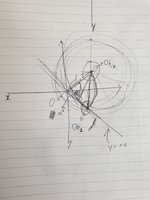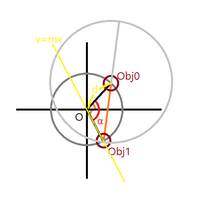I need to get position of a object (can be anything) when rotated alpha° based on mid point O.
I tried to solve this by using a feature of circle and line's meeting point- but there were several issues regarding, but first I will tell you the conditions.
- I know the value alpha
- I know where exactly object is before I rotate it = know the distance between O and not-moved object's middle point.
- Mid point O is (0, 0)
- You can make a lot of triangles and circles to solve this, but I want simplest way to solve this- even its quick-and-dirty way.
- Distance between object and O is ALWAYS SAME.
Now the issues,
- I tried to solved this by using x=0 or y=0 between moved position and feature of circle and a line's meeting point (circle is made of a line between moved and not-moved object's middle point, line is between O and moved object's middle point). Has a limitation because when moving to 351 to 348 didn't have x=0 or y=0 at the middle (does not have to be exact) of it. Any other way than drawing y=-4x or such things like this?
- As I mentioned "meeting point" above, sometimes it was not a single point. So I need to know condition to programmatically define to choose a single point. Just tell me how I can logically tell which point is the point I actually want.
I tried to solve this by using a feature of circle and line's meeting point- but there were several issues regarding, but first I will tell you the conditions.
- I know the value alpha
- I know where exactly object is before I rotate it = know the distance between O and not-moved object's middle point.
- Mid point O is (0, 0)
- You can make a lot of triangles and circles to solve this, but I want simplest way to solve this- even its quick-and-dirty way.
- Distance between object and O is ALWAYS SAME.
Now the issues,
- I tried to solved this by using x=0 or y=0 between moved position and feature of circle and a line's meeting point (circle is made of a line between moved and not-moved object's middle point, line is between O and moved object's middle point). Has a limitation because when moving to 351 to 348 didn't have x=0 or y=0 at the middle (does not have to be exact) of it. Any other way than drawing y=-4x or such things like this?
- As I mentioned "meeting point" above, sometimes it was not a single point. So I need to know condition to programmatically define to choose a single point. Just tell me how I can logically tell which point is the point I actually want.


